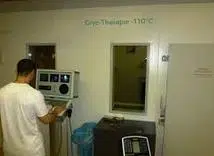 Cryotherapy is the name given to therapy that is based on the use of low temperatures to develop a treatment. The technique consists of applying cold to the body to achieve a certain effect.
Cryotherapy is the name given to therapy that is based on the use of low temperatures to develop a treatment. The technique consists of applying cold to the body to achieve a certain effect.
Cryotherapy is vasoconstrictive, increases blood pressure and has anti-inflammatory, anesthetic and analgesic effects. That is why its use is usually indicated by doctors in the event of certain disorders.
Vascular inflammations and sprains, for example, can be treated with cryotherapy. Also fever, heat stroke and sunstroke. To apply cold, ice packs , creams or gels can be used to cool the area.
Cryosurgery is the cryotherapy used to destroy diseased or abnormal tissues. In this case, the technique is usually used to treat skin problems, whether malignant or benign. Using liquid nitrogen, it is possible to eliminate melanomas, moles and warts . In some cases, argon, carbon dioxide and other gases are used.
Through cryotherapy, specialists manage to generate a large number of chemical reactions inside the patients' bodies that promote the nourishment of the cells, in the same way that they improve and increase blood circulation. Among the benefits of this type of therapy are the following:
* makes the heart muscle work and increases its volumes, especially diastolic filling ( diastole is the movement by which the arteries and the heart relax and expand; it takes place when purified blood passes through them). One volume that does not increase due to cryotherapy is the heart rate;
* promotes the effects of insulin, which improves blood levels of simple sugar. On the other hand, it also increases the secretion of pancreatic and liver enzymes, such as insulin and transaminases, respectively;
* favors the circulation and digestion of gastric substances, and also the evacuation of the large intestine. Likewise, it helps keep the intestinal muscles in shape;
* improves the absorption of food substances and type B vitamins, two phenomena that take place in the small intestine;
* promotes improvements in the transit and circulation of substances in the portal system, thanks to which the body is able to eliminate toxins that accumulate in soft tissues more easily. The organism has several portal systems, and these are those composed of a duct, generally transport or irrigation, that branches until it is unified again.
 Among the many applications of cryotherapy, since it is indicated for various treatments, its use in the world of sports stands out. This is because it allows sports medicine to be complemented to cure injuries of different types, such as muscle overloads, tendinosis, fibrillar microtears and tendonitis, among others.
Among the many applications of cryotherapy, since it is indicated for various treatments, its use in the world of sports stands out. This is because it allows sports medicine to be complemented to cure injuries of different types, such as muscle overloads, tendinosis, fibrillar microtears and tendonitis, among others.
In addition, the performance of athletes can increase as a result of the improvements that cryotherapy causes in blood circulation and the heart muscle, in addition to the elimination of toxic substances. After a very intense exercise session, it can also be used to relax muscles and recover from pulls or blows.
Beyond the benefits that cryotherapy provides, there are also contraindications and possible adverse effects. Complications can range from hives and allergies to changes in blood pressure or even the development of heart disease.
While cryotherapy involves the application of cold, thermotherapy is based on the use of heat to treat injuries and diseases . Heat can be applied by convection, conduction or radiation, both at a superficial level and in tissues located at a deep level.
